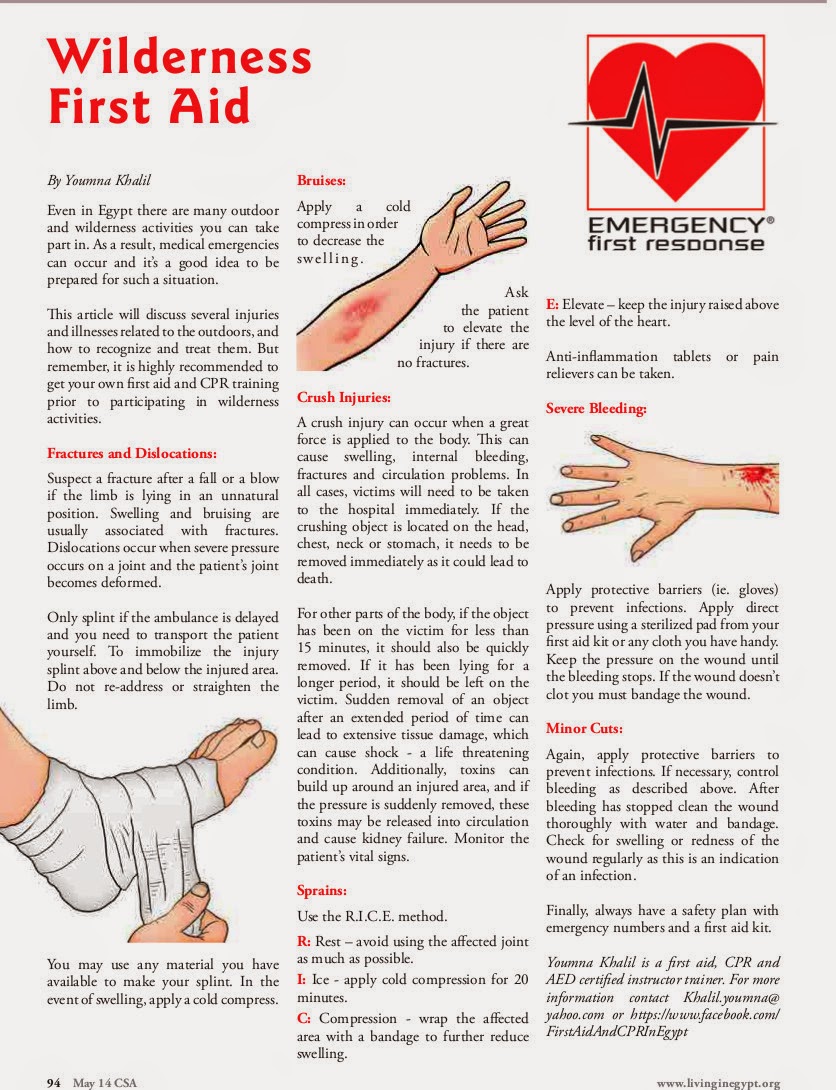Here it the second part of the “Wilderness First Aid” Series”. Last part coming soon!
Even in Egypt, there are many outdoor and wilderness activities you can take part of. As a result, medical emergencies can occur and it is best -as a precaution- to be prepared for such situation.
This article will discuss several injuries and illnesses related to the outdoors, how to recognize and treat them. But remember, it is highly recommended to get your first aid and CPR training prior to going to wilderness activities.
Fractures and Dislocations:
Suspect a fracture after a fall or a blow and if the limb is lying in an unnatural position. Swelling and bruising are usually associated to fractures. Dislocations occur, when severe pressure occurs on a joint and the patient’s joint becomes deformed.
Only splint, if the ambulance is delayed and you will need to transport the patient. Splint above and below the injury, in order to immobilize the member. Do not readdress or straighten the limb. You mayb use any material you have available. In case of swelling, apply a cold compress.
Crush Injuries:
A crush involves any great force applied to the body, this can cause swelling, internal bleeding, fractures and circulation problems. In all cases, victims will need to be taken to the hospital immediately.
If the crushing object is over the head, chest, neck or stomach, it needs to be removed immediately as it could lead to death.
If the object has been over the victim for less than 15 minutes, it should be quickly removed. If it has been lying for a longer period, it should be left on the victim. Sudden removal of an object after a long time, can lead to extensive damage body tissue, causing shock which is a life threatening conditions. In additions, toxins usually build up around an injured area, and when the pressure is suddenly removed, toxins are released into circulation causing kidney failure.
Monitor the patient’s vital signs.
Sprains: Use the R.I.C.E. method.
R: Rest the affected member and avoid its usage as much as possible.
I: Ice, apply cold compression for 20 minutes.
C: Compression, wrap the affect area with a bandage to further reduce swelling.
E: Elevate the injury above the heart level
Anti inflammation tablets or pain relievers could be taken.
Bruises:
Apply cold compress in order to decrease the swelling. Ask patient to elevate the affected member if there are no fractures.
Severe Bleeding:
Apply protective barriers such as gloves in order to prevent infections. Apply direct pressure using a sterilized pad from your first aid kit or any cloth you have handy. Keep the pressure on the wound till the bleeding stops. If the wound doesn’t clot, then bandage the wound.
Minor Cuts:
Apply protective barriers such as glove. Control bleeding if necessary as mentioned above. Then clean the wound thoroughly with water and bandage the wound. Check for swelling or redness of the wound regularly (it is an indication of an infection).
Finally, always have a safety plan with emergency numbers along with a first aid kit.
Stay tuned for part 3!

